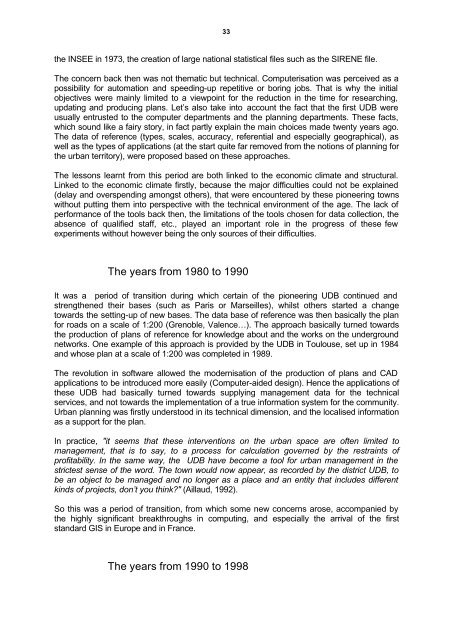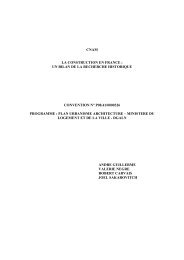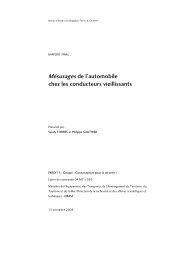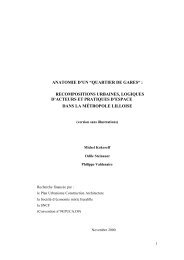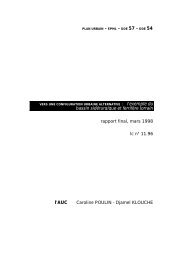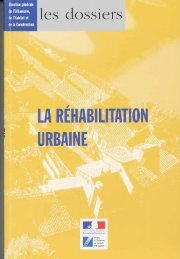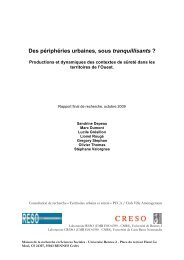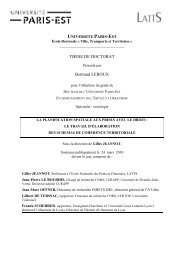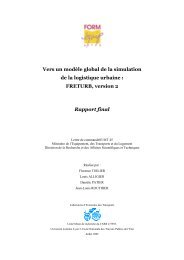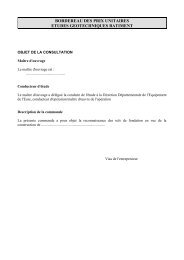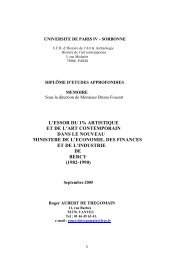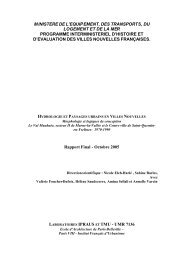Systèmes d'information géographique. Dossier ... - CiteSeerX
Systèmes d'information géographique. Dossier ... - CiteSeerX
Systèmes d'information géographique. Dossier ... - CiteSeerX
You also want an ePaper? Increase the reach of your titles
YUMPU automatically turns print PDFs into web optimized ePapers that Google loves.
33<br />
the INSEE in 1973, the creation of large national statistical files such as the SIRENE file.<br />
The concern back then was not thematic but technical. Computerisation was perceived as a<br />
possibility for automation and speeding-up repetitive or boring jobs. That is why the initial<br />
objectives were mainly limited to a viewpoint for the reduction in the time for researching,<br />
updating and producing plans. Let’s also take into account the fact that the first UDB were<br />
usually entrusted to the computer departments and the planning departments. These facts,<br />
which sound like a fairy story, in fact partly explain the main choices made twenty years ago.<br />
The data of reference (types, scales, accuracy, referential and especially geographical), as<br />
well as the types of applications (at the start quite far removed from the notions of planning for<br />
the urban territory), were proposed based on these approaches.<br />
The lessons learnt from this period are both linked to the economic climate and structural.<br />
Linked to the economic climate firstly, because the major difficulties could not be explained<br />
(delay and overspending amongst others), that were encountered by these pioneering towns<br />
without putting them into perspective with the technical environment of the age. The lack of<br />
performance of the tools back then, the limitations of the tools chosen for data collection, the<br />
absence of qualified staff, etc., played an important role in the progress of these few<br />
experiments without however being the only sources of their difficulties.<br />
The years from 1980 to 1990<br />
It was a period of transition during which certain of the pioneering UDB continued and<br />
strengthened their bases (such as Paris or Marseilles), whilst others started a change<br />
towards the setting-up of new bases. The data base of reference was then basically the plan<br />
for roads on a scale of 1:200 (Grenoble, Valence…). The approach basically turned towards<br />
the production of plans of reference for knowledge about and the works on the underground<br />
networks. One example of this approach is provided by the UDB in Toulouse, set up in 1984<br />
and whose plan at a scale of 1:200 was completed in 1989.<br />
The revolution in software allowed the modernisation of the production of plans and CAD<br />
applications to be introduced more easily (Computer-aided design). Hence the applications of<br />
these UDB had basically turned towards supplying management data for the technical<br />
services, and not towards the implementation of a true information system for the community.<br />
Urban planning was firstly understood in its technical dimension, and the localised information<br />
as a support for the plan.<br />
In practice, "it seems that these interventions on the urban space are often limited to<br />
management, that is to say, to a process for calculation governed by the restraints of<br />
profitability. In the same way, the UDB have become a tool for urban management in the<br />
strictest sense of the word. The town would now appear, as recorded by the district UDB, to<br />
be an object to be managed and no longer as a place and an entity that includes different<br />
kinds of projects, don’t you think?" (Aillaud, 1992).<br />
So this was a period of transition, from which some new concerns arose, accompanied by<br />
the highly significant breakthroughs in computing, and especially the arrival of the first<br />
standard GIS in Europe and in France.<br />
The years from 1990 to 1998


